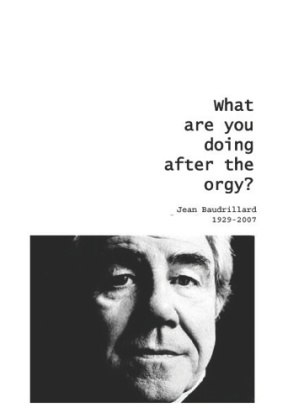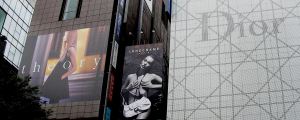
The concept of symbolic exchange is crucial and foundational for most of Jean Baudrillard’s theorizing on mass society, media society and can help to understand the often contradictory and whimsical way in which he presents his critique. If you have reached this page looking for the quick and dirty definition of symbolic exchange, you will be disappointed. Because if you are trying to understand the concept, you already have made the first step in reducing the number of possible meanings. Most basically, symbolic exchange is a form of exchange that maintains and organizes social relations and hierarchies. The difference to other forms of exchange is that the value of an exchanged object does not value the act of exchanging it. Symbolic exchanges are not aimed at establishing equivalence (equal value) between two exchanged tokens, as in the exchange of money for goods or services. The easiest example of a symbolic exchange is “doing someone a favor.” Often based on an already established relation, the favor is not calculated in monetary terms but is part of a series of acts which maintain and keep up a relation. The difference to monetary exchanges is marked by the strong rejection of any form of payment for such “favors.”
Pre-modern Symbolic Exchange and Production
For Baudrillard the importance of symbolic exchange is its pre-capitalist dimension. Symbolic exchange rejects (or does not know) the profit-oriented calculation of investments and returns, which Max Weber had defined as the characteristic feature of Western capitalism (see his chapter on the Spirit of Capitalism, or the “Vorbemerkung zu den gesammelten Aufsätzen zur Religionssoziologie“). In Baudrillard’s work, the book “Symbolic Exchange and Death” (fr. 1976; engl. 1993) marks a crucial turning point. The title refers to the perception of time in so-called primitive cultures, which relies on a cyclical model instead of a linear one. Life and death are not separate, but are coextensive forms of presence. In regular, ritual festivities, the living “animate” the deceased, make them part of their present so that both the living and the dead inhabit the same space. This exceptional time of the ritual is also a period where the regular activities of daily life are suspended, were riches are wasted (potlatch, expenditure, consumption in the sense of ‘destruction’) and are not invested. The more one wastes during such a ritual, the higher one’s social standing is within the group. The ability to waste, to give all that one has in a symbolic act, marks an individuals social rank and is a source of recognition. Georges Bataille drew attention to this anti-economic model of society, which he viewed as a way to critique capitalism. Douglas Kellner has summarized that
Bataille and Baudrillard presuppose here a contradiction between human nature and capitalism. They maintain that humans „by nature“ gain pleasure from such things as expenditure, waste, festivities, sacrifices, and suchlike, in which they are sovereign, and are free to expend their energy excess and thus follow their „real nature.” (Jean Baudrillard, 1989: 42)
What Baudrillard finds interesting in such forms of negating exchange, which destroys value instead of creating profit, is the critical perspective it allows for his analysis of capitalism. With the linear, profit-oriented thinking of capitalism, the category of death suddenly becomes the opposite of life, just as waste (ie. consumption) becomes the opposite of production. This thesis is already prepared in his book “The Mirror of Production” (fr. 1973; engl. 1975) where he underlines in a crucial passage (Chapter 2: “Marxist Anthropology and the Domination of Nature”) how early capitalism regards the excavation of raw materials from nature as the initial value creation of its enterprise.
Raw nature is the non-value of production, because the resource it provides (ore, lumber, coal) does not have a price in and of itself. With the excavation of raw materials from nature, capitalism also produces “nature” as a sign, which is antithetical to itself. Were capitalism is organization, dirt and conflict, nature becomes Eden, pure and wild. Only by itself from nature in such a way, does modern production (and culture) create /nature/ as a sign. With linear thinking (cmp. Hegel’s teleology of history) the world becomes divided into opposing pairs (life/death; value/non-value; object/subject; consumption/production; reality/non-reality) gradually replacing the pre-modern notion of complementary parts forming the world as a cosmological unity. The title “Symbolic Exchange and Death” effectively summarizes that capitalist society has annulled its Other, it has destroyed all alternatives, by making death not the component part of life but its opposite. Capitalism has annulled death, and thus has annulled all alternatives to itself, all opposites to itself. The book marks a turning point because Baudrillard only begins to talk about simulation and hyper-reality as founding concepts of capitalism after a long reflection on the creation of value in capitalism in his early works.
Language and the Symbolic
Besides the economic dimension of symbolic exchange, Baudrillard also includes a linguistic-cultural dimension in his concept of simulation, “the radical negation of the sign as value” as he terms it in his famous essay “The Precession of Simulacra” (Simulacra and Simulation, 1994: 6). In an idiosyncratic equation between the value of production and the value of the sign as meaning, Baudrillard picks up debates in French semiotics of the 1960s and 70s which reflected Roland Barthes’ semiology, or the structure of signs and their meaning. At some point, Baudrillard rejects the semioticians’ obsession with the meaning of signs, and the entire idea of finding a mechanism or theory which could, with mathematical precision, explain the formation of meaning as such.
Where Barthes keeps up a distinction between denotation (literal meaning) and connotation (associative meaning) of signs, Baudrillard poses that “denotation is never anything but the most beautiful and the most subtle of connotations” (Pour une Critique de l’Economie Politique du Signe, 1972: 192; engl. 1981). Baudrillard thus draws attention to the arbitrariness of defining one meaning of a sign as its essence, while relegating all other meanings to the realm of secondary associations. This definition of a core meaning is in itself a social convention, the result of power relations between editors, academics and publishers. In fact, the illusion of anything as definite as a core meaning of a sign covers up the constant process of negotiation over meanings. The social life of signs is marked by a constant ambivalence, which according to Baudrillard, makes it impossible to fix meanings. The symbolic dimension of a sign is here especially interesting because it plays at the knowledge of a particular meaning, yet negates the value of this meaning. In the symbolic act, the literal meaning is converted into something completely different, which is admittedly open to debate. The symbolic is thus subversive of the sense of the value of signs as meaning (See also my article “define: symbolic“). This dimension of signs to escape definite meanings in social interaction prepares Baudrillards insistence on the power of simulation in the mass media.
In summary, symbolic exchange is a crucial and complicated critical concept for understanding the early and middle works of Baudrillard. It includes a theory of modernity, of production, of value and capitalism, which in turn is derived from an idiosyncratic blend of French post-war semiotics with a Marxist analysis of society. Of central importance is the distinction (whether actual or rhetorical) between pre-modern societies and capitalism, between cyclical and linear models of time, between production and consumption and above all, value as a common category of production (exchange value) and language (as sign value or meaning). Baudrillard thus fuses an economic theory with a theory of language to arrive at a theory of the mass media as key historical actors of the proliferation of simulacra.
*** Coda on Resources for Research ***
The best resource on this whole subject is Mike Gane’s book “Jean Baudrillard. Critical and Fatal Theory” (Routledge, 1991), on which I relied for much of my research. Based on Gane but more focused on the role of mass media in Baudrillard’s theorizing of society is William Merrin’s “Baudrillard and the Media” (Polity Press, 2005) and William Pawlett’s “Jean Baudrillard. Against Banality” (2007). For a reference guide to the scattered occurrence of individual terms and concepts, the index compiled by Gerry Coulter in 2007 provides an excellent resource. Here you will find the many meanings of symbolic exchange in all of Baudrillard’s writings (p. 126/7). The Journal of Baudrillard Studies continues and expands the critical work on Baudrillard’s theories in the present. My own book on the role of symbolic exchange in Baudrillard’s early works was published in 2009. See the entry for more details or download the book (in German).
*** PS ***
“What are you doing after the Orgy” was an essay by Baudrillard, published in Artforum in Oct. 1983. It plays through a number of ways in which the media constitute reality as spectacle of exposure. The term “obscenity” is used frequently by Baudrillard, which brings together an obvious moral judgement on such exposures, but also a pun on the “ob-scene”, the non-scene which the media create for their own spectacles. The analogy is basically that the media use preconceived models (decors, settings, plots and narratives) to create the scenes in which certain signs (images, discourses, sounds) are presented – most often detached from the contexts in which these signs were recorded or “lived”.
The Italian miracle is the miracle of the scene.
The American miracle is the miracle of the obscene.
Luxury of the senses against the deserts of insignificance. (p.46)



